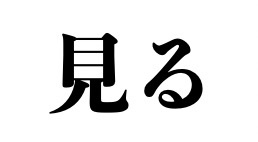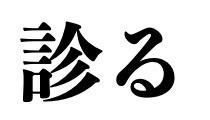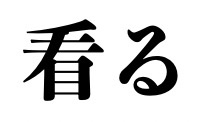What is the differences in nuance and meaning between 見る,観る,診る, and看る(miru) in Japanese.
Do you know the difference between the nuances and meaning of 見る,観る,診る,and 看る in Japanese?
These are all read the same way.
It reads “miru”.
In English, there are words like “watch,” “look,” and “see” that have largely the same meaning with different nuances of meaning, right?
見る, 観る, 診る, and 看る are another such differences.
I will now explain the differences between them.

What are the nuance and meaning of 見る(miru) in Japanese?

meaning
This is the meaning of the English words “see”, ” watch”, and “look”.
In Japanese, “see”, “watch”, and “look” all refer to “見る”.
The past tense is “見た” (mita).
present continuous tense is “見ている” (miteiru)
past progressive tense is “見ていた” (miteita)
model sentence
I saw you at the cafe yesterday.
昨日、カフェであなたを見たよ。
If I have time to look at my phone, I’ll study English.
携帯を見る時間があったら、英語を勉強しよう。
I fell asleep watching TV.
テレビを見ていたら、寝てしまった。
What are the nuance and meaning of 観る (miru) in Japanese?

meaning
This is used when watching a movie or play.
The past tense is “観た” (mita).
present continuous tense is “観ている” (miteiru)
past progressive tense is “観ていた” (miteita)
model sentence
I watched the movie and cried.
映画を観て、泣いてしまった。
I saw a play and longed to be an actor.
劇を観て、役者に憧れた。
The word “観劇” can be used to describe watching a play.
What are the nuance and meaning of 診る(miru) in Japanese?

meaning
This means to examine a medical condition or health condition.
The past tense is “診た” (mita).
present continuous tense is “診ている” (miteiru)
past progressive tense is “診ていた” (miteita)
model sentence
I’m not feeling well, so I’m going to see a doctor.
調子が悪いので、医者さんに診てもらう。
What are the nuance and meaning of 看る in Japanese?

meaning
This means to take care of the sick.
The word “nurse” is written in kanji “看護師”
The past tense is “看た” (mita).
present continuous tense is “看ている” (miteiru)
past progressive tense is “看ていた” (miteita)
model sentence
Taking care of a child with a cold
風邪を引いた子供の面倒を看る。
There are differences in nuance between them.
Please try to understand the difference between these nuances and use them in different ways!
Please take a look at this as well.
COMMENTS